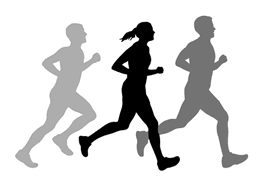The Runner’s Guide to Sports Hernias
 You’re running and you start to feel a dull, achy pain in your abdominal area. Maybe pulling or stretching feeling in your groin? You may be suffering from a sports hernia. A fairly uncommon injury in runners, a sports hernia is a soft tissue injury to your groin and lower abdominal area caused by sudden, sharp, twisting movements.
You’re running and you start to feel a dull, achy pain in your abdominal area. Maybe pulling or stretching feeling in your groin? You may be suffering from a sports hernia. A fairly uncommon injury in runners, a sports hernia is a soft tissue injury to your groin and lower abdominal area caused by sudden, sharp, twisting movements.
Sports hernias are characterized by the presence of aching pain in the groin or lower abdominal area when twisting, lifting and impact. Runners may feel pain while jogging and planting their feet, although it may also strike while doing strength training, especially abdominal exercises. Simple daily tasks may also trigger sharp pain that comes on fast.
Sports hernia pain also can also be distinguished by its occurrence in cycles. Usually, a runner will rest and the pain will subside. However, it usually comes back with activity, creating an endless cycle of confusion and uncertainty. With these symptoms, a visit to a sports hernia specialist is definitely warranted.
Other symptoms are not so easy to attribute to a sports hernia injury. Sometimes this injury may present externally as a detectable bulge, but in some other cases nothing is visible. While a bulge may not be visible, it’s crucial to watch and feel for any protrusions.
Preventing a sports hernia injury is not a clear-cut science. The most crucial part of protecting yourself from injury is to make sure that you have a strong core. A sports hernia is an injury to your oblique abdominal muscles, which are often weaker than the surrounding front abdominal, quadriceps and trunk muscles. Because of this, it’s important to strengthen those muscles specifically to minimize your chances of a sports hernia.
Not only should core muscles be strong, but flexible as well. Stretching after a run, whether it’s around the block or a full-on marathon, helps to keep muscles free of tension, keeping a potential sports hernia injury at bay. Several stretches can be added to your list to lessen your likelihood of injury. First, the butterfly stretch is crucial and also allows for adjustment depending on your individual level of flexibility. Another great stretch is the standing groin stretch, which starts with a wide stance and involves touching each elbow to the opposite knee. Finally, lunges are a great way to strengthen both your quadriceps and groin muscles at the same time.
Although running isn’t usually a high-risk sport for development of sports hernias, it’s important to be able to recognize causes, symptoms and prevention in order to make sure you stay healthy and on your feet.
